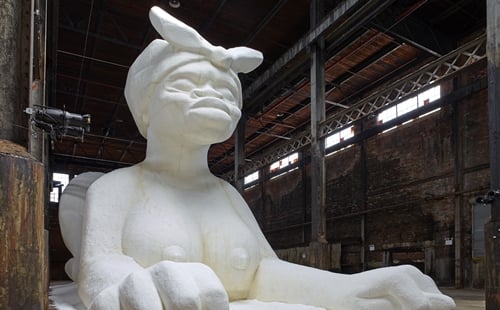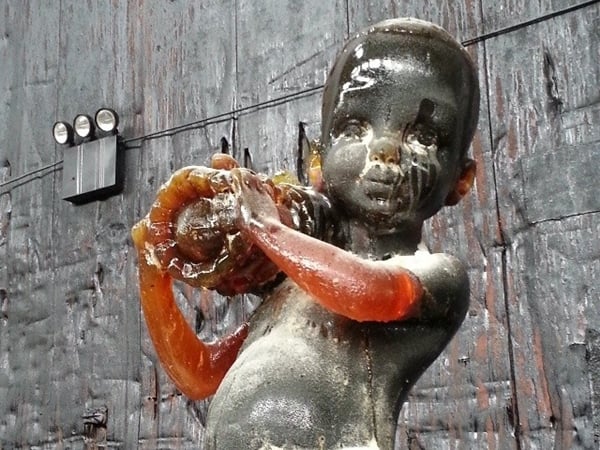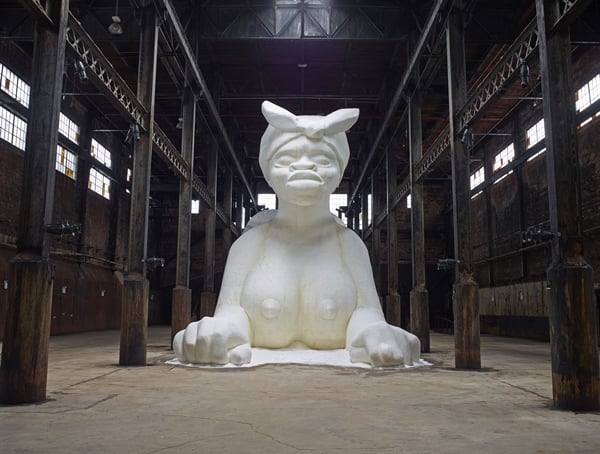Art & Exhibitions
Kara Walker on Her Bittersweet Colossus
The artist has raised a pharaonic monument to sugar, out of sugar.

The artist has raised a pharaonic monument to sugar, out of sugar.

Benjamin Sutton

The historic Domino Sugar Refinery in Williamsburg, Brooklyn, is about to be converted into a plush abode for yuppie gentrifiers. But before it gets hipsterized, it will serve as a lair for a different sort of beast, a giant sphinx sculpted from white sugar by Kara Walker. The monumental work, with the body of a feline and the bust of a stylized, racist stereotype of a black woman, will be surrounded by more than a dozen statues of a young boy, some of them made of hard candy. The calorie-rich installation was commissioned by Creative Time and aims to explore the ways in which the trans-Atlantic slave and sugar trades overlapped, and their shared, enduring legacies. It is a startling departure for an artist best known for her silhouette cut-outs, paintings, and animated videos.
Walker spoke to artnet News about the exhibition—officially titled A Subtlety, or the Marvelous Sugar Baby an Homage to the unpaid and overworked Artisans who have refined our Sweet tastes from the cane fields to the Kitchens of the New World on the Occasion of the demolition of the Domino Sugar Refining Plant (2014)—which opens May 10 and continues through July 6.
When did you begin working on this project?
It’s really been a short period of time. They approached me either last April or May. I think I did a site visit in May of last year. And I had lots of ideas right away because it’s the kind of space that makes you aware of a lot of different pasts and presents and futures. So it wasn’t a problem of not having ideas, it was a matter of finding ones that felt right and not completely stupid, or stupid in the right sorts of ways. It’s only been a year. And building out the sphinx and its attendants has been two or three months, a little bit longer with the sketches and models.
How much of the project did you plan out ahead of time and how much of it was generated in response to the locale?
Pretty much all of it. Nato Thompson and Anne Pasternak came to me with this site, this location, and we did a site visit, and any skepticism that I might have had disappeared because the space is just amazing. It’s already this weird cathedral to some bygone era, and the walls are encrusted with molasses, and there’s caked-up sugar and brown sugar and molasses stuck to everything way high up, so it’s a really powerful space. I wanted to take it on, but it also meant trying to challenge and tease out what was relevant in my work and my interests with this kind of space. The space is doing more than 50 percent of the work.

The Domino Sugar Refinery.
Photo: Beyond My Ken. Via Wikimedia Commons.
It took a couple of months to figure out how I was going to engage with the space. There are all kinds of ways that one could—performative, filmic—but it dawned on me after a time that we’d have to go this route. It’s a daunting space to do anything in, and I didn’t know I was going to do sculpture, because I haven’t done sculpture. I’ve been in this mode of trying to challenge myself—well, it’s not even a mode, it’s just always there. I said yes immediately because I felt that I could do it, but then I had to take a look at the whole hubristic, “I can do it!” attitude, which is one part naïve and one part opportunistic. It was fear-inducing on many levels.
Why did you choose to make the sculptures out of sugar?
It’s not a stable material, for sure. The thing that made the most sense about working with sugar was its temporality, that it’s here and then it’s gone, usually ingested or dissolved in some other way. Even the sugar boys, the candy ones, they’re changing every day. There’s little drips, things coming from the interior, they leak. The sphinx is weeping right now, and then it dries, so it sort of lives and breathes in a way; it is very temporary. I’ve been thinking a lot about ruins, things like that.
What attracted you to the figure of the sphinx?
For a while I was trying to do a piece that could embrace the sugar trade, the slave trade, the various meanings that are put upon sugar, as an industry, and then the byproducts of industry, like the molasses, byproducts not just of industry but of slavery. I have this, not exactly a Ven diagram, but this spider-web of references and material that was getting so far out of my reach, there was so much connected to this one substance, past and present, to sugar. There’s the whole spice trade that gets brought in, and sugar as this most precious commodity that maybe is responsible for the rise of the slave trade, and the slave trade is responsible for the presence of Africans and African religions in America—there are so many things going into this piece! We don’t even realize how much we ritualize sugar every day. For the most part people who use sugar use it a lot, and there’s sugar all around us, and it’s sort of built this world. It’s this empire that we pay homage to every day.
And why a sphinx? Who knows. It’s the guardian of the temple, it’s the guardian of the city, it’s the possessor of the secret of the riddle, it’s a thing that will devour you if you don’t understand it. It came to me when I realized that I needed to make a thing, when I realized that I needed to make a monument to this substance. A monument that’s kind of easily digestible, in a way, and kind of loaded. But she’s not just a sphinx; she’s in the position of the sphinx but she’s another woman, an African woman figure.
I read this quote somewhere in my research, I don’t remember his name, but he was a Jesuit priest in Brazil somewhere, and he wrote a book and one of the first lines was: “Brazil is sugar and sugar is the black man.” And it was clear in the 17th century that sugar was equated with African bodies who were producing sugar. And since I’m a woman, I made her a woman.

Kara Walker, A Subtlety (2014, detail).
Via @creativetimenyc/Instagram.
In addition to the sphinx, what will visitors encounter at the sugar plant?
There are—or there will be, god willing—about 15 attendants. There are five, or four-and-a-half at the moment, and there will be 15 of these little boy figures in all. They’re just under five feet tall and appropriated from a much smaller gift sculpture that you find in Hallmarks and what have you. The ones that we’re making here on-site are made of candy. They’re basically big, blown-up Jolly Ranchers made from a solution that’s sugar, corn syrup, and water boiled to a candy, “hardball” consistency. It’s called the hardball stage, when you boil candy to 300 degrees, so they’re solid-ish, but they’re like 300 pounds each of pure sugar, which is kind of insane. The other ones will be made of another material, but treated in the same way.
How do you think people will react to this monument that seems both ancient and very contemporary?
I’m anticipating a number of different responses to the piece, and I think because it’s so large and domineering that it’s impressive in that sense. Nudity is a thing, apparently, that people have a problem with; not slavery, or racism, but female bodies, or bottoms.
Is that type of response something you’re used to by now, given your previous work?
I don’t think I can ever get used to it, because I’m kind of reserved but I have this inner six-year-old, so there’s a moment where I completely forget. Working on this project has been goofy and messy and sticky and enjoyable with the team and everybody putting it together. But there’s a moment when you have to step back and take it all in, and ask, what all am I being responsible for, in reality?
What’s it like being there every day?
It’s really beautiful. It’s a like a cathedral. There are these high factory windows all around, and some of them have been smashed and some of them have molasses on them, and some of them are brown, so there’s this amazing mosaic pattern up on the windows. And the light comes streaming down in these ridiculous layers in the morning, it’s like, come on! And then you have the presence of this colossus that’s being built, and it’s both kind of abstract and kind of weirdly personified and has a kind of vitality in it that’s slightly terrifying.
Why did you choose to use white sugar for your sculpture?
I was playing with other sugars for a while. I was either in my kitchen or in my studio boiling different sugars, playing with brown sugar, playing with Turbinado sugar, cooking it, making candy with it. I sort of liked them all, I would have used them all. But I liked the contrast between the dark interior of the space and this white, crystalline thing that happens when you pack that much sugar onto a surface—it’s really striking. And then the light streaming in through the windows at all these ridiculously romantic angles, coming in through the skylights. Her head is pretty much just under the skylights, so at certain times of the day, like at noon, it’s kind of blinding.
Kara Walker’s “A Subtlety” runs May 10–July 6 at the Domino Sugar Refinery in Williamsburg, Brooklyn.

Kara Walker, A Subtlety (2014).
Photo: Jason Wyche, Courtesy Creative Time.